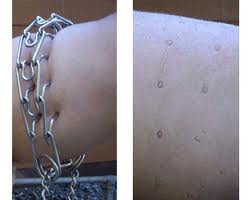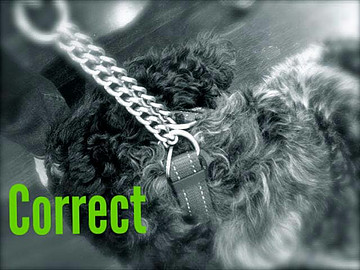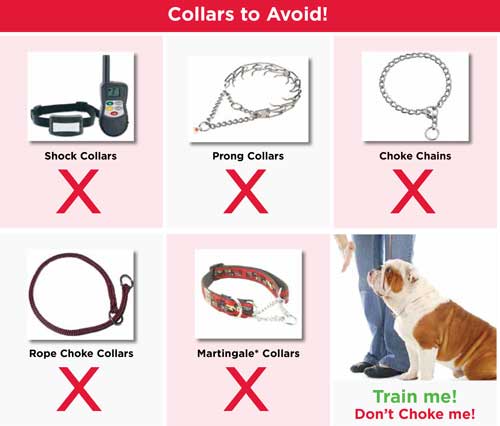Before you start reading the following lines, I invite you to do a little test. Open your hands keeping your thumbs together. Place the thumbs at the base of the throat and the fingers around the neck. Now, take a deep breath, squeeze and pull back with all your force, keeping your thumbs connected.
If you have not fainted by now and are still reading these lines, I am sure the sensation was not comfortable. Perhaps you never thought about it, but this is how many dogs feel when they are on the leash.
If you are still keen to continue with this experiment, put a choke chain around your neck and attach it to a leash. Ask a friend to grab the end of the leash and pull and jerk on it periodically. Welcome to the dog world!
No, I will not make you go on with this experiment and ask you to test another torture device, the prong collar. I just want you to become more aware of what is happening.
-Dr. Peter Dobias, DVM
What collar corrections/prong collars/ choke chains will do to Fido!
Aside from the physical damage the above collars will do to your dog, there is actually lots of physiological damage that will happen as well!
Psychological Damage
Clinical studies have shown that the use of some dog training collars INCREASES the negative behaviours owners are trying to correct and CREATES new problems which are substantially worse than a dog pulling on the leash. Dogs learn by association. If they’re wearing a choke or prong collar, which provides painful corrections, they can associate the object they see or the environment they’re in at the time of correction as the source of their pain. If your dog pulls or lunges when another dog approaches, their collar tightens up, providing a painful correction. In a short period of time, your dog can become conditioned to react negatively every time he sees another dog. When you apply the psychology, it looks like this: see another dog = get excited = pain = fearful or aggressive response. Here’s the risk- the next time your dog sees another dog he’s going to become fearful and may likely offer an aggressive response designed to scare the other dog away before it causes him to get hurt again.
Physical Damage
Any collar that tightens or provides concentrated pressure points on the dog’s throat can cause physical injury. A serious and irreversible injury is common in dogs that wear these collars long-term and continued strain on the leash. The throat and neck are quite sensitive, and scar tissue quickly develops from repeated bruising of the muscles and ligaments. Scar tissue deadens feeling in the area.
irreversible injury is common in dogs that wear these collars long-term and continued strain on the leash. The throat and neck are quite sensitive, and scar tissue quickly develops from repeated bruising of the muscles and ligaments. Scar tissue deadens feeling in the area.
Dogs lose their sensitivity when this occurs and can literally choke or receive puncture wounds before they feel the pain of their actions. Aside from the choking risk, permanent damage is evidenced in labored or noisy breathing, a “goose-honk” cough, and frequent dry coughing. Many dogs will suffer a collapsed trachea from these collars.
It does not take a lot of pressure to sustain an injury of this magnitude. Allowing a device to physically punish your pet in the presence of children or other animals can quickly create fear resulting in child-aggressive and dog-aggressive animals. Once learned, both behaviours are enormously challenging to unlearn.
 Even a flat buckle collar can cause damage if you are "jerking" or "collar correcting" Its best to not use pain and force for your dog's health and well being.
Even a flat buckle collar can cause damage if you are "jerking" or "collar correcting" Its best to not use pain and force for your dog's health and well being.

Martingale Collars!

Pro's of a Martingale
When fitted correctly it does NOT choke your dog like a choke chain
The pressure is distributed around the neck, rather than concentrating in one area (the trachea), which is preferable but can still cause damage if pulling for a long time or fitted incorrectly
Some models now offer a quick release buckle
Meant for breeds with a particular conformation, heads that are smaller than their necks as seen in sighthounds (Greyhounds, Italian greyhounds, whippets, Salukis, rough collies, and borizoi)
Con's of a Martingale
It is not meant to be left on all day
Can be dangerous if left on while they are playing
Martingale chains may rust and stain a dogs coat
In order to be safe and effective, it must be fitted correctly
It is NOT designed to help dogs with pulling, add a front clip harness to help with pulling
 Incorrect Fitting of a Martingale Collar
Incorrect Fitting of a Martingale Collar

Incorrect Fitting
When the Martingale collar is fitted the incorrect way you run the risk of choking your dog, causing trachea damage or even behaviour issues associated with the collar.
Example: Mouthing/biting when touching/putting on the collar.
Correct Fitting
When the Martingale collar is fitted correctly it should not choke or cause damage. (You should NOT be collar correcting)
It helps with dogs who have a history of backing out of collars.
Shock Collars/Bark Collars
The study concluded that the use of shock collars is clearly inhumane. Behavioural and physiological measures of welfare showed how dogs that had been trained using electric shocks were significantly more stressed and tense than dogs taught using positive methods. There was also a trend for “shocked” dogs to take longer to learn basic obedience commands.
Even when a shock collar was no longer used, the anticipation that a shock may be used during a training session was enough to stress many dogs, indicating that there are also long-term effects on anxiety levels and trainability. Shock collars are already banned in some parts of Europe, and the findings within this report suggest that others will soon follow suit.
-REBECCA LEDGER, Vancouver Sun
 Martingale collars should ONLY be used for dogs who need them, read above for when you should use one for your dog and fit it CORRECTLY
Martingale collars should ONLY be used for dogs who need them, read above for when you should use one for your dog and fit it CORRECTLY
